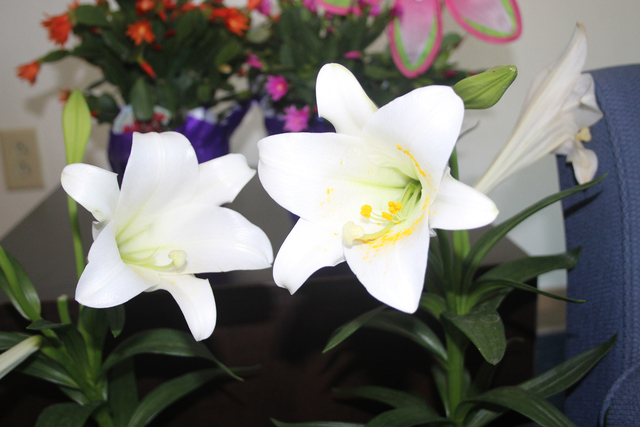New gardening column opens with a look at Easter lilies
Today the Review-Journal begins a new gardening column by Angela O’Callaghan, an associate professor at University of Nevada, Reno College of Cooperative Extension. As social horticulture specialist, she administers the Master Gardeners of Southern Nevada, Food for Thoughts (school gardens), the Growing in Small Places series and community gardens programs.
She earned her bachelor’s degree in chemistry at the State University of New York, and obtained her master’s degree in fruit and vegetable science and doctorate from Cornell University. She also earned a certificate in horticultural maintenance at the Arnold Arboretum of Harvard University.
Before joining the faculty at Nevada Cooperative Extension in 2000 to create the social horticulture program, O’Callaghan was a research technician at the Laboratory for Bioenergetics at State University of New York at Albany and a research assistant at the Howard Hughes Medical Institute of Harvard University Medical School. Steven Kalas’ column, which previously appeared in this space, will run in the Monday Health section beginning this week.
● ● ●
Plants and their flowers are often associated with particular seasons — poinsettia and mistletoe are inescapable at Christmastime, and what would Valentine’s Day be without spectacular roses? Like many events that have a religious background, Easter has its own floral emblem, the Easter lily.
This spring-blooming beauty is a true lily, unlike its remote cousins, the day lilies, which are marvelously attractive, but members of a different genus. Neither of these is even remotely close to water lilies.
Stately and pure white, growers have been able to encourage its blossoms so they appear just in time for Easter. Left to its own devices, the plant would produce flowers closer to summer, but they are a welcome sight earlier in the spring.
Like many other early spring flowers, lilies grow from bulbs, making them more similar to onions than to poinsettias.
The potted plant will continue to flower indoors for a few weeks if the environment is comfortable for it. The plant needs to be evenly moist, but not wet. Drainage is key for most plants, but for a bulb like a lily, it is essential. It will rot if it is sitting in waterlogged soil.
To keep this from happening, remove the foil that often wraps the pot when it arrives. It prevents water from draining out of the pot.
Although it must have good drainage, the plant does not do well in excessively dry air. If it is possible to increase the humidity, the plant will do better.
After taking off the wrapper or plastic sleeve, set the pot on some rocks in a tray with water. This will help make its atmosphere a little more comfortable.
Bright, indirect light is best to keep it growing while inside. It does not need fertilizer while indoors.
Although the flowers will have passed after a few weeks, the plant itself is not dead. The bulb is full of life and can bloom next year if it is planted outside. This is not a difficult process. Once it has stopped blooming, let the foliage die back but continue to water. This will prevent the bulb from desiccating.
Find the coolest area of the garden, which can be something of a challenge in Southern Nevada, with north or northeast light. Dig the hole a little deeper than the pot was — roughly about 6 inches deep.
The soil should be amended with a little compost to improve drainage and workability, but the only fertilizer that it should receive at that time would be a product designed for bulbs.
The soil should remain slightly moist through the winter. A 2- to 3-inch layer of mulch, like shredded bark, will help. Mulch also keeps soil temperatures more even — less hot in summer and less cold in winter.
Next spring it will produce green leaves and shoots. That will be the time to give it fertilizer. After growing 2 or more feet tall, it will produce its lily flowers. This will be later than Easter, however, closer to Memorial Day. It will still be beautiful.
The downside of Easter lilies is that they are toxic to cats. If a pet eats any part — foliage, stem or flowers — it can result in kidney failure, and in some cases, death. Even though the cat may vomit the plant part it ate, the toxin might still be in its body. For this reason, take the kitty to the vet as soon as possible.
Other lily-type plants, such as calla lilies or peace lilies, do not have this potentially fatal effect. If the cat is prone to eating plants, consider one of these.
Angela O’Callaghan is the social horticulture specialist for University of Nevada Cooperative Extension. Contact her at ocallaghana@unce.unr.edu or 702-257-5581.




























